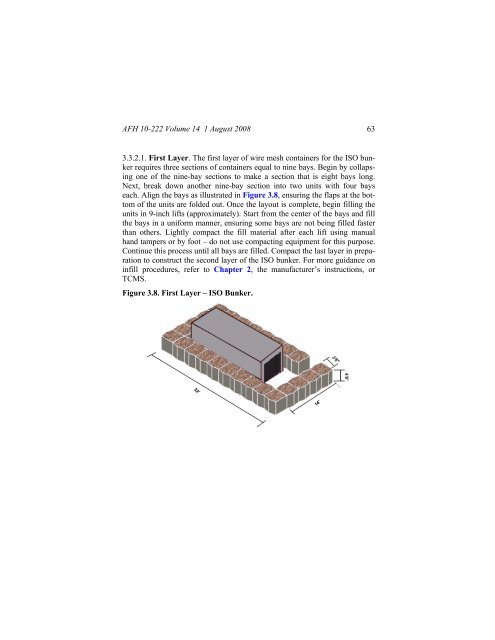Civil engineer guide to fighting positions, shelters, obstacles
Civil engineer guide to fighting positions, shelters, obstacles
Civil engineer guide to fighting positions, shelters, obstacles
You also want an ePaper? Increase the reach of your titles
YUMPU automatically turns print PDFs into web optimized ePapers that Google loves.
AFH 10-222 Volume 14 1 August 2008 63<br />
3.3.2.1. First Layer. The first layer of wire mesh containers for the ISO bunker<br />
requires three sections of containers equal <strong>to</strong> nine bays. Begin by collapsing<br />
one of the nine-bay sections <strong>to</strong> make a section that is eight bays long.<br />
Next, break down another nine-bay section in<strong>to</strong> two units with four bays<br />
each. Align the bays as illustrated in Figure 3.8, ensuring the flaps at the bot<strong>to</strong>m<br />
of the units are folded out. Once the layout is complete, begin filling the<br />
units in 9-inch lifts (approximately). Start from the center of the bays and fill<br />
the bays in a uniform manner, ensuring some bays are not being filled faster<br />
than others. Lightly compact the fill material after each lift using manual<br />
hand tampers or by foot – do not use compacting equipment for this purpose.<br />
Continue this process until all bays are filled. Compact the last layer in preparation<br />
<strong>to</strong> construct the second layer of the ISO bunker. For more guidance on<br />
infill procedures, refer <strong>to</strong> Chapter 2, the manufacturer’s instructions, or<br />
TCMS.<br />
Figure 3.8. First Layer – ISO Bunker.
















